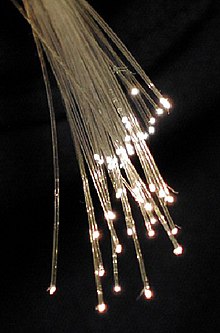Ffibr optig
Ffeibr ystwyth, ysgafn a thryloyw wedi'i wneud o wydr neu blastig yw fibr optig, sydd ychydig tewach na thrwch blewyn y gwallt. Gall weithio fel canllaw i donnau optig neu i gludo golau o'r naill ben i'r llall. Gelwir y maes oddi fewn i wyddoniaeth gymhwysol a pheirianneg sy'n ymwneud â chynllunio a chymhwyso'r ffibrau hyn yn 'ffibr optig'.[1][2]

Cânt eu defnyddio'n helaeth oddi fewn i'r maes 'cyfathrebu', gan fod y ffibl hwn yn caniatáu i ddata deithio heb ymyrraedd ac ar fand mwy llydan na cheblau weiren ac am bellter hirach. Oherwydd nad metel yw eu gwneuthuriaeth, ni cheir ymyriant electromagnetig. Fe'u defnyddir hefyd i oleuo, a gellir eu casglu'n fwndeli twt i gario delweddau, sy'n eu gwneud yn hynod o ddefnyddio mewn lle bychan, cyfyng. Gellir eu defnyddio hefyd fel synhwyryddion ac i gario laser.
Hanes
golyguDrwy 'blygiant', mae golau'n cael ei lywio aer hyd y ffibr; dyma egwyddor sylfaenol ffibr optig a chafodd ei brofio am y tro cyntaf gan Daniel Colladon a Jacques Babinet ym Mharis yn y 1840au cynnar. Sgwennodd Tyndall am y darganfyddiad yn 1870.[3]
Mae blewyn di-liw, dynol, hefyd yn gweithio fel ffibr optig ac yn cario golau o'r naill ben i'r llall.[4]
Cyfeiriadau
golygu- ↑ Peipen Olau Jargon File
- ↑ Thyagarajan, K. and Ghatak, Ajoy K. (2007). Fiber Optic Essentials. Wiley-Interscience. tt. 34–. ISBN 978-0-470-09742-7.CS1 maint: multiple names: authors list (link)
- ↑ Sgwennodd John Tyndall: When the light passes from air into water, the refracted ray is bent towards the perpendicular... When the ray passes from water to air it is bent from the perpendicular... If the angle which the ray in water encloses with the perpendicular to the surface be greater than 48 degrees, the ray will not quit the water at all: it will be totally reflected at the surface.... The angle which marks the limit where total reflection begins is called the limiting angle of the medium. For water this angle is 48°27', for flint glass it is 38°41', while for diamond it is 23°42'
- ↑ Wells, J. (1989). "Hair light guide". Nature 338 (6210): 23. Bibcode 1989Natur.338...23W. doi:10.1038/338023b0. PMID 2918918.